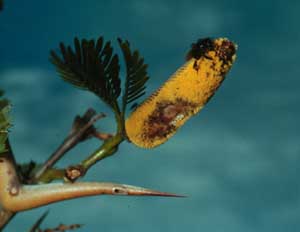|
|
 35 inflorescence & bee DHJanzen100117.jpg high resolution
|
|
| The ant-acacia inflorescence contains hundreds of tiny florets packed side by side, only a few of which have the potential to be fertilized. They produce massive amounts of pollen (here, yellow) that is collected by bees that whip in, land, collect, and move on before being attacked by the acacia-ants. The acacia-ants are also not vigorous about patrolling the inflorescences and the old mature branches that bear them. In other words, the ant-acacias are insect-pollinated (as are other species of Acacia) by insects that basically can and do move in and out of the tree crown with relative impunity (in contrast to insects intent on feeding on foliage). In this particular photograph of Acacia cornigera in Veracruz, Mexico, the bee is a Trigona (Apidae), which is a stingless bee that commonly scavenges pollen from many kinds of flowers and is a pollinator of only some of them (and here might indeed not really be pollinating, but just scavenging). | ||
back to lecture slides
or skip to: